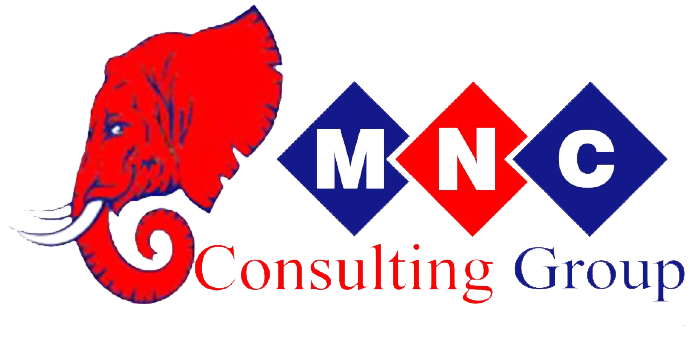- Home
- About
- Services
- Audit and Assurance
- Taxation in Kenya
- Human Resource Management
- Business Process Outsourcing(BPO)
- Consultancy and Advisory
- Management Advisory
- Assets and Investments Advisory
- Business Transformation and Turnaround
- Business Start-ups Incubation
- Family Business Advisory
- Financial Advisory
- Business and Corporate Strategy
- Property Advisory
- Business Valuation
- Business Plan Formulation
- Funding Proposals
- Mergers, Acquisition (M & A) and Restructuring
- Transaction Advisory Services
- Crisis Management
- Monitoring and Evaluation (M&E)
- Communication Services
- Industries
- Transportation
- Agriculture and Agribusiness
- Processing and Manufacturing
- Hospitality, Leisure and Tourism
- Construction and Real Estate
- NGOs and Charitable Trusts
- Distribution and General Trading
- Consultancy
- Financial Services
- Automotive Machinery & Equipment
- Water and Sanitation
- Healthcare
- Technology
- Energy, OIl, and Gases
- Betting and Gaming
- Education
- Resources
- Careers
- Contact us
- Login
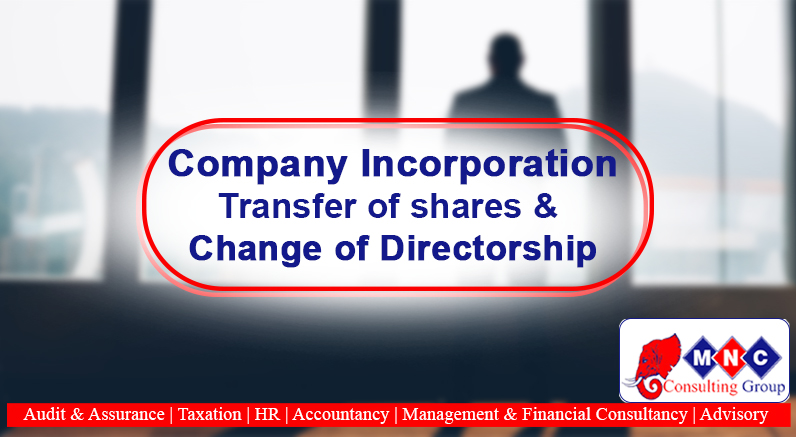
Company Registration, Transfer of Share(s) and Change of Directorship of a Company
- March 23, 2023
- administrator
- Blog
- No Comments
[vc_row][vc_column][vc_custom_heading source=”post_title” use_theme_fonts=”yes”][vc_column_text]Definition and regulation of a company. A company is legal separate entity (also referred to as ‘artificial person’) formed by an individual or group of individuals (also referred to as ‘natural persons’) to engage in the commercial or industrial activities. In the Republic of Kenya, company incorporation is the process undertaken by a promoter of a company to register a company with the registrar of companies as prescribed by the Companies Act, 2015. Major differences between a company and other forms of business entities A. Company registration Requirement for company registration In Kenya to register a company the following are the requirements: The proposed name of company. Nature of the business and the intended objectives of the company. Names of the proposed directors of the company. Names of the proposed shareholders/ members if different from the directors. Contact information of the directors and shareholders i.e. email address, telephone number, postal address and residential addresses. Proposed nominal capital of the company Proposed capital structure of the company. Class of shares being issued by the company. Passport photographs of the proposed directors and shareholders. Proposed physical address of the company. The process of company registration in Kenya The promoter of the company will lodge the process of incorporation with the registrar of companies by; Fronting at least three names of the company according to the order of their preference. Executing the following documents; Form CR1- Application for Registration Form, Form CR2- Model Memorandum of Association, Form CR6- Notice of Appointment of Directors and Particulars, Form CR8- Notice of Residential Address of Directors, Statement of Nominal Capital and, Statement on the proposed beneficial owners of the company. Making payment with the registrar of companies. Thereafter, the registrar confirms the name reserved. In completion the registrar of companies issues a certificate of incorporation. Transfer of share(s) and change of directorship Transfer of share(s) and change of directorship of a company is usually lodged with the registrar of companies by one of the existing director(s) of the company or by a Certified Public Secretary of Kenya (CPSK) on behalf of the company. The process of transfer of shares and/or change of directorship occurs when the company intends to; Increase or decrease the number of members and/or, Increase or decrease the number of directors. At MNC Consulting Group, we help our clients realize the proper procedure for their needs and facilitate in the process to ensure that process is duly lodged and completed in accordance to the law stipulated in the Companies Act, 2015. General requirements for transfer of share(s) and change of directorship Copy of Certificate of Incorporation, The company must have filled all its annual returns for the previous years with the registrar of companies and, The company must file interim returns (for part of the current incomplete year). For addition of director(s) and member(s)/shareholder(s) the following must be present; Minutes of the meeting in which the resolution(s) were made, Full name of the new officer(s) (i.e. director(s) or member(s)), Consent from the person(s) being appointed as director(s), Contact information i.e. email address, telephone number, postal address and residential addresses, Passport size photo for the new director(s) or member(s) and, Class and number of shares being issued to a new member. For reduction of director(s) and member(s)/shareholder(s) the following must be present; Minutes of the meeting in which the resolution(s) were made, Written resignation letter and affidavit from the outgoing director(s) and, Parties involved i.e., the transferor(s) and transferee(s) should sign a transfer deed (Form of transfer). Following the execution of the above stated requirements and documents, we at MNC Consulting Group follow the statutes requirements in the Stamp Duty Act, and thereafter lodge the transfer with the registrar of companies. At MNC Consulting Group, we not only provide you with fast and reliable services for your business but also offer you fast and reliable communication. Our experienced experts have reputably given our clients confidence through excellent customer service to individuals and groups of individuals (both locals and foreign nationals) seeking to company related services in Kenya. Follow this link to FIND OUT THE TRANSACTION COST OF COMPANY REGISTRATION, TRANSFER OF SHARES AND CHANGE OF DIRECTORSHIP About the Author Thank you for reading this article. The author, James Ndambiri is an avid Business Advisor and Consultant: A Tax Surgeon, Proficient Accountant, Skilled Auditor, a Guru in Financial and Investment management, Expert in Business Strategy Formulation, Business Transformation Wizard, Family Business Advisor, Lecturer, Business Coach and a Family Man. James is the Founder, Team Leader, CEO & Managing Partner of MNC Consulting Group. MNC Consulting Group is your most trusted and respected professional business consulting firm recognized by our clients for delivering excellent business advisory and consulting services that create value to their ventures. With our focus set on value addition, we offer our clients the highest quality professional services in Accounting, Audit and assurance, Tax, Business Transformation, Investments and Financial Advisory, Family Business Advisory, Company Secretarial Services and Property Management that addresses their business needs through attracting, recruiting and retaining knowledgeable and passionate professionals who enable us to deliver superior results while contributing positively to the community in which we live and work. Make us your business partner by always consulting with us. ‘‘With us, you are in safe hands’’[/vc_column_text][/vc_column][/vc_row] Consult Us
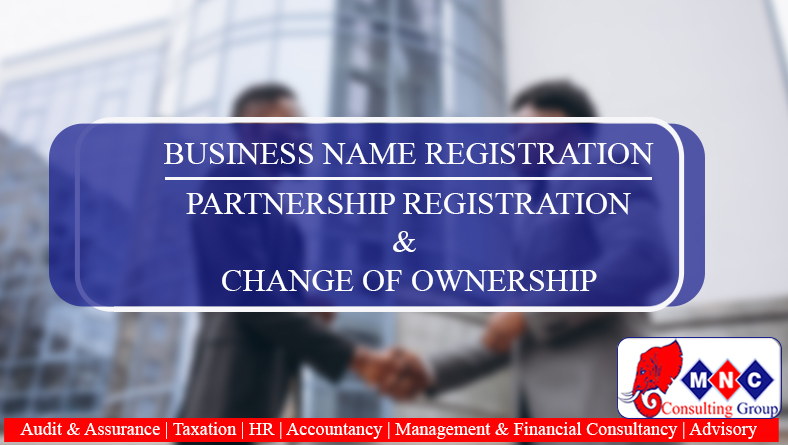
Business Name, Partnership Registration and Change of Ownership
- March 23, 2023
- administrator
- Blog
- No Comments
[vc_row][vc_column][vc_custom_heading source=”post_title” use_theme_fonts=”yes”][vc_column_text]BUSINESS AND PARTNERSHIP REGISTRATION AND CHANGE OF OWNERSHIP Major differences between a sole proprietorship, partnership and other forms of business entities (A) Business name and partnership registration Requirement for business name and partnership registration In Kenya to register for a business name and/or a partnership, the following are the requirements: The proposed name of the entity, Nature of the business and the intended objectives of the entity, Names of the proposed proprietor (for business name) or partners (for partnership), Contact information of the proprietor (for business name) or partners (for partnership).i.e. email address, telephone number, postal address and residential addresses, Proposed profit/loss sharing ratio (for a partnership), Passport photographs of the proposed proprietor (for business name) or partners (for partnership) and, Proposed physical address of the entity. The process of business name and partnership registration in Kenya The promoter of the entity will lodge the process of registration with the registrar of companies by; Fronting at least three names of the entity according to the order of their preference. Executing the following document; Form BN2 – Application for Registration Form, Making payment with the registrar of companies. Thereafter, the registrar confirms the name reserved. In completion the registrar of companies issues a certificate of registration. (B) Change of ownership In sole proprietorship, the natural person is the entity and therefore, the entity cannot change ownership. However, in partnerships, the process of change of ownership occurs when the partnership intends to; Increase the number of partners or, Decrease the number of partners. Here at MNC Consulting Group, we help our clients realize the proper procedure for their needs and facilitate in the process to ensure that process is duly lodged and completed in accordance to the law stipulated in the Partnership Act. For addition of partners, the following must be present; Copy of Certificate of Registration, Minutes of the meeting in which the resolution(s) were made, Full name of the new partner(s), Contact information i.e. email address, telephone number, postal address and residential addresses and, Passport size photo for the new partner(s). For reduction of partners, the following must be present; Copy of Certificate of Registration, Minutes of the meeting in which the resolution(s) were made, Written resignation letter and affidavit from the outgoing partner(s) and, Following the execution of the above stated requirements and documents, we at MNC Consulting Group follow the statutes requirements in the Stamp Duty Act, and thereafter lodge the transfer with the registrar of companies. Payment is then made to the registrar who upon satisfaction that the process lodged is valid, approves the changes. Follow this link to FIND OUT THE TRANSACTION COST OF BUSINESS NAME AND PARTNERSHIP REGISTRATION AND CHANGE OF OWNERSHIP About the Author Thank you for reading this article. The author, James Ndambiri is an avid Business Advisor and Consultant: A Tax Surgeon, Proficient Accountant, Skilled Auditor, a Guru in Financial and Investment management, Expert in Business Strategy Formulation, Business Transformation Wizard, Family Business Advisor, Lecturer, Business Coach and a Family Man. James is the Founder, Team Leader, CEO & Managing Partner of MNC Consulting Group. MNC Consulting Group is your most trusted and respected professional business consulting firm recognized by our clients for delivering excellent business advisory and consulting services that create value to their ventures. With our focus set on value addition, we offer our clients the highest quality professional services in Accounting, Audit and assurance, Tax, Business Transformation, Investments and Financial Advisory, Family Business Advisory, Company Secretarial Services and Property Management that addresses their business needs through attracting, recruiting and retaining knowledgeable and passionate professionals who enable us to deliver superior results while contributing positively to the community in which we live and work. Make us your business partner by always consulting with us. ‘‘With us, you are in safe hands’’[/vc_column_text][/vc_column][/vc_row]
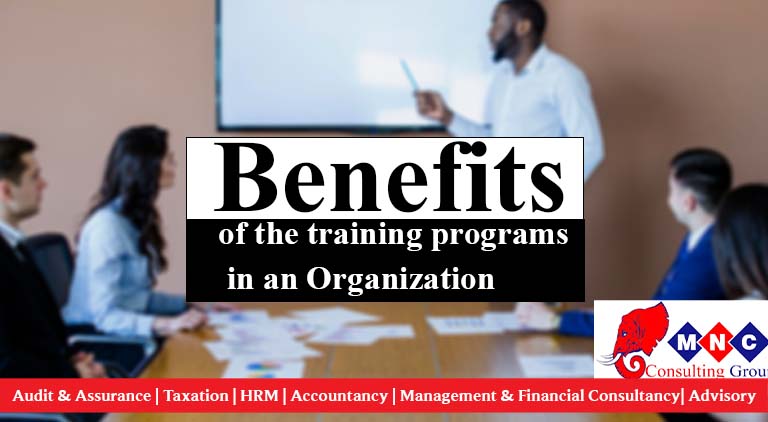
BENEFITS OF TRAINING PROGRAMS IN AN ORGANIZATION
- February 3, 2023
- administrator
- Article
- No Comments
Training can be defined as system used by companies / organizations to improve skills and performance of the employees. This is an educational tool which consists of information and instructions to make existing skills sharp, introducing new concepts and knowledge to improve the employee performance and giving an organization competitive advantage. Our training programs are divided into: Employee training – This is done to improve business outcomes by implementing internal educational programs that advance employees’ knowledge and skills. Management training – This program targets people with leadership skills. E.g., managers and supervisors. It’s aimed at improving individual leadership skills and managerial ability. BENEFITS OF TRAINING PROGRAMS IN AN ORGANIZATION Increases the employee’s productivity Improve employee motivation and create an atmosphere of self-regulation Helps employees gain more confidence in their abilities thus leading to greater job satisfaction, absenteeism, and overall employee retention. Attracts highly skilled employees Increases consistency and greatly improves quality of work Creates a sense of teamwork and collaboration. Continuous training programs help ensure employees have the knowledge and skills to perform tasks safely. Creates an environment of a knowledgeable team where an employee can help to train or assist each other as needed. Training improves the creativity and innovation of the employees hence positively contributing to the company’s growth and continued success. At MNC, we recognize training as an important tool for ensuring employees have the right skills that make them more efficient and effective toward to the organization. A knowledgeable team; Has a sense of confidence always Feels motivate Works at a minimal error rate Are self-reliant and regulated Engage us and experience a changed workforce full of positive attitudes and commitment to productivity. All this is a result of a tailored training program that will fit your industry the best way. To assist your business growth and meet your organizational goals, some of our training programs focus on the following areas: Critical evaluation Cultural effective Leadership Communication and ethics Relationship management Creativity and innovation Let us assist you meet your organizational goals by consulting with our HR experts.
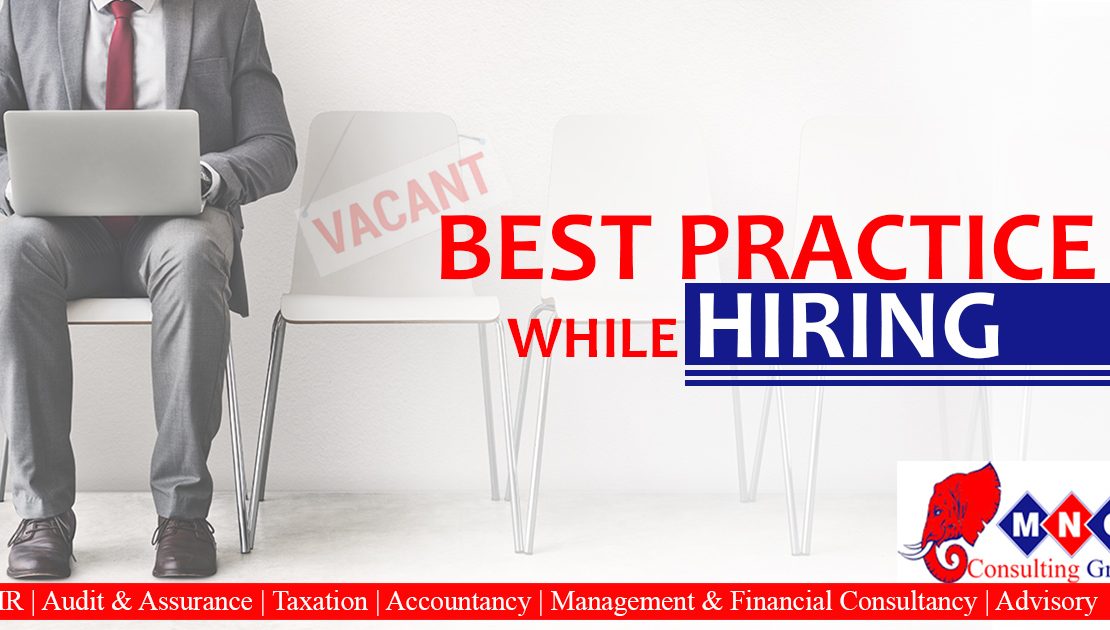
BEST PRACTICES WHILE HIRING
- December 14, 2022
- administrator
- Article
- 2 Comments
The growth and development of any organization depend heavily on the hiring of new talent. Bringing new talent can result in the development of new ideas and insights. The process of hiring can be a time-consuming and resource intensive process. Hiring employees who have not been thoroughly screened can end up being costly to the business and investment. This is referred to as “Bad Hires”. Establishing best hiring practices helps to safeguard your business/company during the hiring process. A bad hire is simply an employee who proves not to be a good fit or match within their individual role or for the organization. In other cases, a bad hire could have misrepresented or exaggerated their qualification or expertise during the hiring process and unable to perform after being hired. Bad hires are frequently believed to be people with high turnover rates. However, they can also be employees that perform poorly or don’t fit in with the company culture. This is can be challenging to spot during the recruitment process. In order to reduce your risk of onboarding bad hires this article will assist you to develop a standardized method that can apply during the talent acquisition process. The following are best practices an employer can use to protect his / her company during the recruitment process. BUILD A STRONG EMPLOYER BRAND Building a strong employer brand help in reducing the risk of bad hire this is by making sure that your organization is desirable to high-quality candidates and your current employees. This can make your company desirable which can lead to an increase in qualified applicants. Having a strong brand identity, image, culture, and personality are key. This not only lowers the rate of turnover but it also reduces the likelihood that your ideal candidate makes the effort to seek you out. CREATING AN EFFECTIVE JOB DESCRIPTION To attain the best talent, it is very important to streamline the process of talent recruitment. This involves creating effective and engaging job descriptions that will attract the right people. It is essentially important because it is the nerve center of the qualification and role for the position to be filled. Be specific as you can, the more information you provide about the position’s responsibilities and qualifications, the more likely it is that you receive applications from qualified candidates. The company’s culture and values should be highlighted in the job description as well. CONSIDERING INTERNAL PROMOTIONS Looking at your current job force and sourcing for internal advancement can benefit your company greatly. Your qualified internal staff makes excellent candidates as well, even though fresh applicants might provide a different perspective, promoting from within can help save your company time and money. Along with employee retention, it can boost your staff’s morale. When a promotion is made from within, there is less risk. Since you are aware of the candidate and have previously been screened and observed, the confidence is high and the element of uncertainty is eliminated to a good degree. Your internal applicant is already familiar with the workplace environment, culture, and objectives and is probably interested in staying with the company. CLARITY ON THE OPEN POSITION. Properly determining the status of each open position from start is another important measure of protecting your company from a bad hire. Determining the status of the job positions refers to whether the position is subject to Kenyan labor laws or qualifies for an exemption. The labor laws’ status of a position will impact eligibility for overtime, the applicability of minimum wage requirements, and other wage and hour requirements, and any exemption from the Kenyan labor laws is determined based on a position’s job duties and salary tests. APPLICATIONS REQUIREMENTS It is a wrong idea for businesses to do hiring without the use of applications. While it can be tempting to use a referral and shorten the hiring process, this is not an ideal way to reduce the risk of a bad hire. Applications are legally binding documents that require a signature. This means that there is accountability regarding the legitimacy of the information you receive. It may also help protect you from employment claims such as discrimination. CREATING AN INTERVIEW PROCESS When you begin to interview applicants, you need to have a process in place that allows for replication over time. This helps increase the likelihood that your interviews are consistent and compliant. If you do not have a system that is followed in the same manner for each applicant, you may open your company to serious legal risk. Some ways to improve the interview process include training managers about proper techniques and preparing questions in advance. You should have a list of open-ended questions that encourage the candidate to speak and a list of pre-approved follow up questions that may be asked as needed. The questions should only be based on any knowledge, skills, or abilities required for the job. All questions that may elicit information about age, gender, religion, national origin, marital status, disability or other protected classes, even indirectly, need to be avoided in the interview process. You should also avoid asking any prohibited questions, such as those that have to do with criminal or salary history. You should also avoid making any hiring decisions based on a person’s physical appearance. The main goal is to conduct each interview without allowing any personal, sometimes unrecognized, bias to affect the decision-making process. The interview process should be well-tailored to achieve objectivity for valid and successful results. CONSIDERING BACKGROUND CHECKS AND SCREENING Conducting background checks is a way to secure information about your potential candidate. Make sure the background screen is administered at the proper time in the application process. The background checks can include criminal screening, verifying employment and education, or more depending on the job responsibilities. The past and history of the candidate are very important during the hiring process for it provide the character information necessary for any organization. EMPLOYEES REFERENCES CHECKS Employee references should also be checked once…

Roll Out and Implementation of Tax Invoice Management System (TIMS)
- July 30, 2022
- administrator
- Article
- No Comments
[vc_row][vc_column][vc_column_text]What is TIMS? Is a Tax Invoice Management System that is an upgrade of the current Electronic Tax Register (ETR). In order to streamline VAT administration, KRA is in the process of implementing of Tax Invoice Management System (TIMS) which will enhance the current ETR program that was rolled out in 2005. What is the origin of TIMS? On September 2020, the cabinet secretary of the national treasury gazetted the Value Added Tax (VAT) (Electronic Tax Invoice) regulations to usher in a new electronic tax invoice regime. This regulation required all VAT registered taxpayer to comply within twelve months upon gazettement. However, KRA issued a public notice citing its plan to rollout the new electronic tax invoice requirements commencing 1st August 2021. The public notice further gave a twelve-month transition window from the rollout date for the tax payer to comply. This means that all VAT taxpayer should onboard on the new system by 30th July 2022. What are the objectives of implementing the Tax Invoice Management System? Tax Invoice Management System will help in the following; Plugging loopholes that result from the weaknesses of the ETR program. Improving accuracy in automated VAT data management Minimizing VAT fraud through invoice data verification Foster tax compliance and minimize tax revenue leakage. What are the benefits of the Tax Invoice Management System (TIMS) to the VAT Taxpayers and the general public? The general public and VAT taxpayers will benefit from the following; Encourage and promote a fair business environment It will make it faster to process VAT refunds VAT returns filing will be simplified Tax register activation will be automated which is added advantage to the VAT taxpayers With the system there will be a non-intrusive verification of the tax process It will help to build trust between the customer and the business entity TIMS assist in enhancing tax compliance How do you comply as a VAT taxpayer? In order to comply with the regulation, a VAT-registered taxpayer should acquire a compliant tax register from KRA-approved ETR Suppliers. The list of the approved ETR suppliers of compliant tax registers is provided on the KRA website. What are the types of the ETRS model? The approved suppliers and manufacturers have different ETR models which are categorized into; Who requires an ETR Device? The regulations requires businesses with an annual turnover of at least Kshs.5 million to install electronic tax register (ETRs) connected to KRA online system (Itax) as an upgrade of the current manual tax register. What are features one should look for when onboarding TIMS? Integration with trader systems, i.e. ETRs, ERPs, and Point of Sale systems (POS). Standardization and authentication of tax invoices issued by VAT traders on a real-time basis. Seamless integration with iTax. A module for storage of tax invoice data. Verification of the validity of a tax invoice for use by officers, traders, and the general public through the Tax Invoice Checker on the iTax portal or Mobile app. What are the features of a valid tax invoice? The invoice should have the pin and the name of the trader It should have a serial number It should contain the buyer PIN which is optional The invoice should have the total gross amount and total tax amount It should contain the tax rate It should have a unique register identifier It should contain a digital signature How does TIMS operate? TIMS operates by the use of a control unit connected or integrated into the existing trader system. The control unit performs the function of tax invoices validation, encryption, signing, transmission, and storage. The communication between the control unit and the TIMS application server at KRA can only be done over the internet. However, the connection between the control unit and the trader system does not have to be on the internet. It can either be integrated into the trader system or attached to it. Occasionally, the trader is required to access the internet in order to enable the transmission of the data to TIMS. What happens in case of loss of internet connection? The taxpayer should continue using the tax register as usual. Once the internet connectivity is restored, the invoices generated and stored in the tax register’s memory will be automatically transmitted to TIMS at KRA. Which internet should be used? The device has the ability to connect to three communication protocols i.e., Wi-Fi, 4G /3G and Ethernet connection. What are requirement for onboarding TIMS? To onboard TIMS one should meet the following requirements; One should be a registered for VAT in accordance with the provision of the VAT Act 2013. Have an invoicing system with the capability to transmit invoices to KRA systems. Have internet connectivity. How does a VAT taxpayer come on board with TIMS? The following is the process of onboarding; Acquire a compliant tax register from KRA suppliers from authorized manufacturers To enable activation, the ETR supplier configures the details of the tax register and the VAT taxpayer who is already registered for VAT on iTax The VAT taxpayers receive an email from iTax confirming the details of the tax registers assigned to them which they are supposed to accept. On accepting the tax register is activated by KRA and becomes ready for use What is the effective date of TIMS? The effective date for the commencement of TIMS will be on 1st August 2022 What is the extended deadline date for complying with Tax Invoice Management System (TIMS)? The deadline date of complying with the regulation of Tax Invoice Management System (TIMS) was extended to 30th September 2022. This was due to VAT taxpayers request to be given more time to acquire and activate the KRA TIMS enabled device. What are penalties for not onboarding TIMS?Failure to comply with the regulation is an offence which attracts penalties as specified in section 63 of 2013. Therefore, for non-compliance one shall be liable to a fine not exceeding Kshs. One million, or imprisonment for a term not exceeding three year or to…
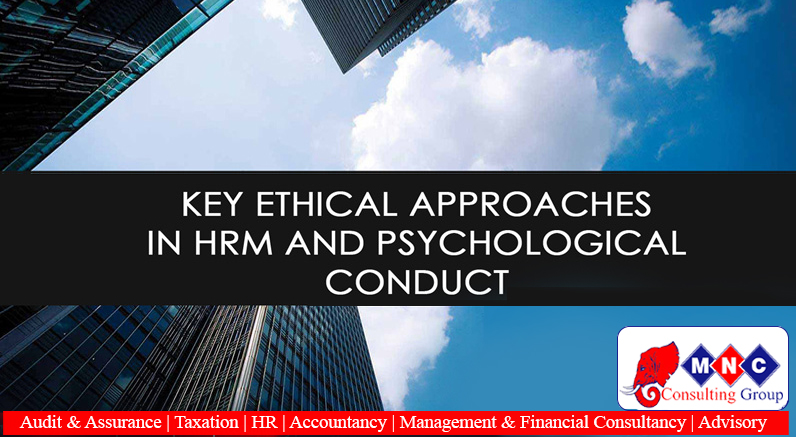
Key Ethical Approaches in HRM and Psychological Contract
- October 27, 2021
- administrator
- Article
- No Comments
What is human resource management (HRM)? It is the practice of recruiting, hiring, deploying and managing an organization’s employees. HRM involves conducting job analysis, planning personnel needs, recruiting the right people for the job, orienting and training, managing wages and salaries, providing benefits and incentives, evaluating performance, resolving disputes, and communicating with all employees at all levels. What is a psychological contract? This refers to the relationship between an employee and his or her employer. It involves mutual outcomes and inputs of each party. Key areas of interest For us to be able to understand the psychological contract of a company, we have to look at it from all points of view. This includes both the employer and the employee. In order to maintain a proper psychological contract in work place, it is important to be ethical in all that we do. A set code of ethics is very important to ensure that no one feels like their rights are being infringed on or even being ignored. Ethical issues A problem or situation that requires a person or organization to choose between alternatives that must be evaluated as right (ethical) or wrong (unethical). A proper code of ethics This is important because it helps change the context under which people view employment. The dynamics have changed greatly, and the social values around us are influencing the quality of work done. This is because the environment that one works in affects the attitude towards work. In a friendly environment the output is better than in a hostile environment. Recently, when operating a business one must abide to certain set code of ethics. This is under the notion of social responsibility by the corporate world. Employers should recognize that everyone working for them has a say and rights that should be put into consideration at all times. If the management is friendly to its subordinates, it makes working more of a team effort than a personal one. The company tends to gain more by using this approach. Personal beliefs The next factor that comes into play is the personal beliefs that every single person has. Despite the fact that there is a set code of ethics, what one believes in his/her heart to be right or wrong also plays a great role in either making or breaking the psychological contract at work. For instant, unjust and corrupt leaders are a good example of people with no sense of wrong and right. If employees abides by a set of principles instilled in them, then this makes workflow easier. However, a certain type of test should be conducted before hiring. The purpose of this test would be to find out what kind of principles the person lives by. Principled people will normally be more aware of the rights of everyone around them and hence reducing the chances of having disgruntled customers. Breach of contracts Some situations may arise that may lead to the breach of contract between the management and the employees. Such cases have led to conflict within the offices and this leads to low work output. An example of such a case is the issue regarding privacy. Sometimes it is hard to protect the interests of the company and at the same time those of the employees. The companies have to monitor all activities of the employees like the emails sent out of company computers. However, it can be seen as a breach of privacy when they go through these emails . Having a code of ethics in human resource management department will be very important at this time. This is because the employees will be able to trust that despite the fact that emails will be sorted through, they are not going to be exposed to the public hence protecting said privacy. Health issue Another issue regarding privacy is the health issue. Some argue that you have to know the HIV status of all the people you employ. However, the employees reserve the right to keep their health status private. However, it is important to recognize that they have to look after the interests of all other employees and not just the one. Some human resource management departments were faced with the dilemma on whether to treat them differently or not. However, people have been made aware of the fact that it cannot be transmitted through contact and hence the rest are all safe. Ethically, you cannot demand that people submit such results. However, the individuals who have such diseases should be careful in their relations with other workers. Due to this reason, most companies prohibit relationships between people working together. Such standards ensure that there is no transmission of such viruses or other STI. Protection of whistleblowers The other issue that has come up in regards to privacy is the protection of whistleblowers. Human resource departments have a hard time determining who is in the right and who isn’t. Whistleblowers are employees who report their bosses when they portray certain unethical behavior. This is a very tough situation because the employees are meant to be loyal to their bosses, there are situations where the good of many outweighs the good of one person. However, if these bosses were to abide by the code of ethics set by the company then there would be no issue to resolve in the first place. By going out of the right path, they put the employees and themselves in a compromising situation that disregards the psychological contract. This is because the bosses also have a responsibility to ensure that the workers are comfortable working at their company. Having a situation where an employee has to turn against the company is not an ideal situation. Discrimination Discrimination among the employees is another factor that human resource management departments have to deal with. Seeing as this is a fairly common practice the government had to come up with a framework to prevent discrimination against sex, race religion or even sexual orientation. Such practices…
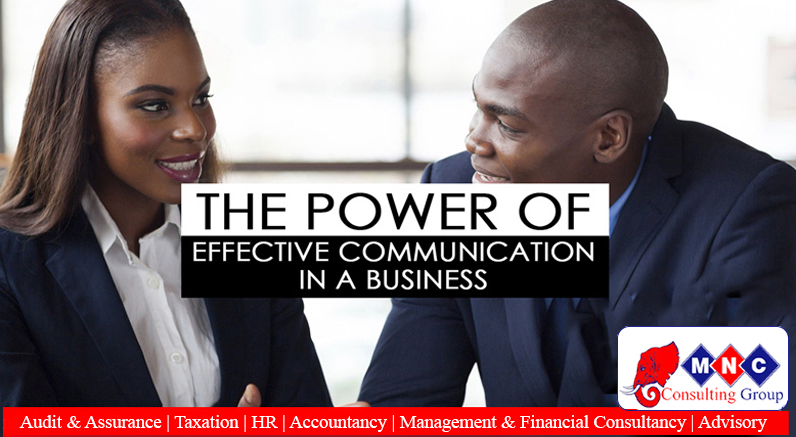
The Power of Effective Communication in a Company
- October 27, 2021
- administrator
- Article
- No Comments
What is communication? Communication refers to the exchange of information either in writing or speaking and this is effective in how any business is able to relate with the customers, employees internally and to the general outsiders of the business externally. Effective communication therefore is a situation where the business is able to clearly and professionally send and receive information in a manner that identifies the business as unique among its competitors. Any business can’t make good sales if there is poor communication. Is effective communication powerful in a business? The answer is YES and having a powerful way to communicate internally and externally in a company will greatly trigger the success of a company. Communication is effective in enhancing the relationship between the customers and the business. It helps to reach out to more consumers as well as giving the customers an opportunity to freely express their opinions, complaints, suggestions and interact with the company with ease. Communication is able to effectively connect the company to more opportunities which can be invested to give additional profits and income to the business. It also reduces time wastage that would have been incurred if the business was to physically engage all its customers, suppliers and employees. Consequently, the only way to build solid wealth in a company is enhancing effective communication across everyone as time management is one of the most critical resources to being successful. How rich you become solely depends on how effectively you manage your time and how effectively a company manages its time entirely depends on effective communication. How to build effective communication in a company? How a company chooses to build its communication largely depends on its financial capacity and the actual size of the company. A smaller company (small and medium enterprises – SMEs) would prefer to use telephone, emailing, and courier services while a large company would use these and even other more expensive ways of communication such as websites, advertising software to communicate with its customers, outsiders, and employees. How much you effectively communicate your business idea will always have a great impact on how much profit a company will achieve at the end of every financial year. Therefore, this implies that any business intending to succeed must therefore plan to expand and gradually build its communication from the simple basics to effective communication. Channels for effective communication in a company? The formal communication channel transmits organizational information, such as goals or policies and procedures, and this further underlines the impact of effective communication in an organization. The channels can be used in marketing a company to increase sales. The main channels of effective communication are: (i) Face to face communication This is a social facial interaction where there is mutual influence of a person’s direct physical presence with his/her body language. It is highly persuasive since there is physical contact between the company representatives (sales team) and the other parties. Also called interpersonal communication. It creates a bond of trust between people due to live feedback translated through the body language and facial expressions, making it a great way to communicate directly to the customers who value trust before doing business. (ii) Mobile/telephone Communication This is the most preferred communication due to its reliability, convenience and is relatively fast in communication. Digital technology has made this channel even more effective in that it has been used on broadcast media marketing, through social networks like face-book, twitter, linked-in and emails. This is a wireless communication that allows transmission of voice and multimedia data via a computer or a mobile device without having connected to any physical or fixed link. Mobile application software such as whatsApp have significantly contributed to this channel of communication making it effective in a great way to a company. (iii) Electronic communication It is a computer-mediated communication in which individuals exchange messages with others, either individually or in groups. The internet is a hub of information and has greatly contributed to its success in most companies, and as a result there has been exchange of ideas and information which have eventually been invested in a business at a profit. (iv) Written communication This is a type of interaction that makes use of written words. It has a great significance in today’s business world, in that it is essential for preparing worthy promotional materials for business development. (v) Broadcast media communication it is mass communication that involves video and audio content usually used by companies for advertisements, where the content is distributed to a dispersed audience with the ability to craft creative and compelling messages to influence people. It combines television and on-air radio performance with opportunities for on-screen acting, motivational speaking and talk show hosting. What are the levels of effective communication in a company? a. Horizontal communication is the transmission of information between people, divisions, departments or units within the same level of organizational hierarchy. It is essential for smooth functioning of organizational activities and for interdepartmental coordination through: Reducing possible misunderstanding and conflict through meeting, discussion and face to face conversations. Improves group efforts and teamwork by reducing conflicts, controversies, and differences in opinions to establish consensus among the managers and workers. Performing smooth inter-departmental communication for larger companies. Gaining benefits of informal communication since the senders and the receivers hold the same position, status and honor. Little or no distortion of message to be communicated because senders and receivers communicate directly with each other. Create dynamism in the workplace to overcome misunderstandings among the managers, leading to an environment of cooperation, teamwork and team spirit. b. Vertical communication which is the transmission of information between different levels of the organizational hierarchy. Strengthens communication where the superior entrusts work to his/her subordinates and watches over them, while acting as a guide and mentor. It is feedback oriented where the top and bottom levels of management discuss and interact with each…
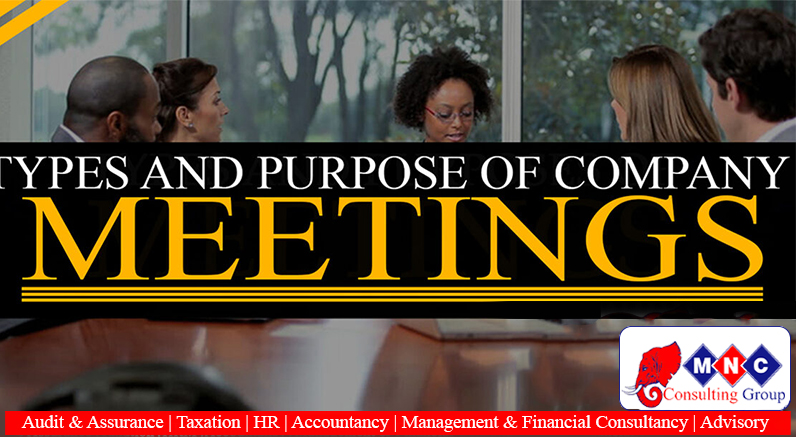
The types and purpose of COMPANY MEETINGS
- October 27, 2021
- administrator
- Article
- No Comments
Types and Purpose of Company Meetings Meaning of company meetings This is when two or more persons (shareholders or the directors or the debenture holder or of the contributories), get together at one place, at a specific time, for lawful purposes, to discuss any common issue. Types of meetings a. Public meetings These are the meetings that consider matters of public concern and to which all members of the public have access, subject to physical limitations of the place where the meeting is held or conditions imposed by any law. b. Private meetings These are meetings attended by people who have a specific right to attend. For example, Committees members of a welfare group or of a registered company. Therefore, company meetings fall under this category. The eight main types of company meetings Statutory Meeting Annual General Meeting Extra ordinary General Meeting Class Meeting Meeting of Debenture Holders Meeting of the Board of Directors Meeting of Creditors Meeting of Creditors and Contributories. The following is an explanation on the above listed types of meetings; 1. Statutory meeting Every public company limited by shares and every company limited by guarantee and having a share capital, must within a period of not less than one month and not more than 3 months from the date at which the company is entitled to commence business, hold a general meeting of the members which is to be called the Statutory Meeting. This meeting is held once in the lifetime of a company. In this meeting, the members are to discuss a report by the directors, known as the statutory report, which contains particulars relating to the formation of the company. Private companies are exempted from holding this meeting. 2. Annual General Meeting (AGM) General meeting of a company means a meeting of its members for specified purposes. Public companies must hold an annual general meeting within or by the end of the six months of its financial year. Private companies are not required to hold an annual general meeting, unless they are a traded company (a corporation whose shareholders have a claim to part of the company’s assets and profits) or their articles require it. Every company must in each year hold, in addition to any other meeting, AGM. The notice conveying the meeting must specify that it is a notice of the AGM. Every AGM must be held during business hours and on working days. The registrar may, for any special reason, extend the time for holding any AGM by any given period; but no extension of time is granted for holding the first AGM. There should be at least one AGM per year and as many meetings as there are years. Ordinary Business of an AGM The normal business transacted at an AGM depends upon the articles. The article provides that the ordinary business of such a meeting shall be: – (i) The declaration of dividends. (ii) The consideration of accounts. (iii) The election of directors in place of the retiring. (iv) Appointment of and fixing of the remuneration of auditors. Any business which is not defined as “ordinary business” of an AGM is known as special business. 3. Extra ordinary general meeting Any general meeting of the company which is not an AGM or a statutory meeting is called extra ordinary general meeting. Extra ordinary meetings can be convened either by the directors whenever they think fit or on the requisition of members of the company. Where directors think fit to convene a meeting, they do so by resolution passed at a duly convened and constituted meeting of the Board. Note that everything transacted at an extra ordinary meeting shall be deemed as special. The extra ordinary general meeting may be convened: – (a) By Board of Directors on its own or on the requisition of the members (b) By the requisitionists themselves on the failure of Board of Directors to call the meeting Extra ordinary meeting convened by Board of Directors: a) On its own: The Board of Directors may call an extra ordinary meeting whenever some special business is to be transacted which in the opinion of the Board of Directors, cannot be postponed till the next AGM. b) On requisition of members: – The requisite number of members of a company may ask for an extra ordinary general meeting to be held. The Board of Directors shall proceed to call such a meeting. The requisition for such a meeting by the members shall be signed: (i) In case of a company with share capital holders of not less than 10% of the paid-up capital of the company having a right of voting in regard to the matter of acquisition. (ii) In case of a company with no share capital, by members representing not less than one tenth of the total voting power in regard to the matter of requisition. A requisition signed by one of the joint owners of the shares has the same force and effects as if it has been signed by all of them. The requisition shall set out all matters for consideration on which the meeting is called and shall be deposited in the registered office of the company. The directors are required to convene such a meeting within 21 days from the date of deposit of the requisition, but if they fail to do so, the requisitionists themselves may convene the meetings, as nearly as possible in the manner required by the company’s articles for convening the meeting. The company must compensate the requisitionists for any reasonable expenses incurred and may repay out of sums payable by the company to such directors as were in default. Note: Unless the meeting is called to pass a special resolution, the requisite notice for an extra ordinary general meeting is 14 days (Saturdays, Sundays, Public holidays are not included). In case of unlimited company, 7 days’ notice is required, but where special resolution is required, 21 days. 4. Class meeting These meetings are held by…
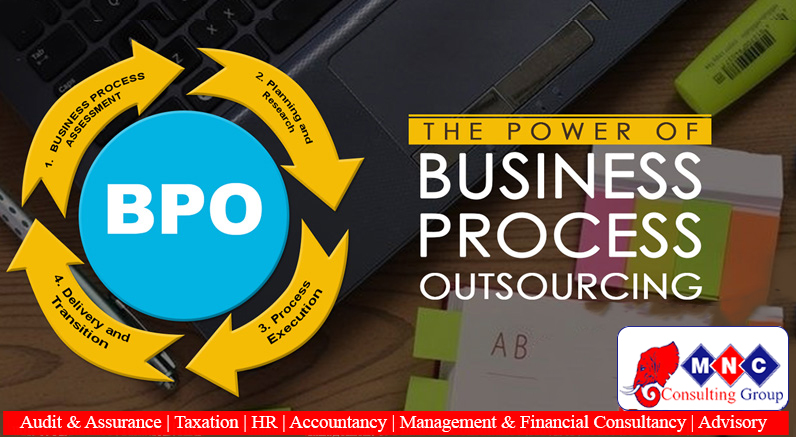
The Power of BUSINESS PROCESS OUTSOURCING (BPO)
- October 26, 2021
- administrator
- Article
- No Comments
What is Business Process Outsourcing (BPO)? Outsourcing (also referred to as contracting out) is a business practice used by companies to reduce costs or improve efficiency by shifting tasks, operations or processes to an external contracted third party for a significant period of time. Therefore, the task to be contracted out can be performed by the third party either onsite or offsite of the business. Why and when do we need Outsourcing? Outsourcing of one’s business functions and activities helps one to concentrate well on one’s core functions and helps controlling costs while working. Consequently, if the following questions come to your mind, then you should consider outsourcing your work: Are we working at a best possible favorable cost? Are the available resources utilized to the fullest efficiency? Whether the current available resources are able to support new technology and fight the market competition? Is there any other efficient way to handle these processes more professionally and quickly? Does the organizational team have the professional expertise to deliver efficient work? How can we cut down the recruitment and training costs? How outsourcing works : Outsourcing involves subcontracting parts of a company’s value-chain, (i.e. steps in the design, supply, production, marketing, sales and services processes) to other companies or contractors that specialize in those activities. Through outsourcing agreements, the client company hires separate companies to perform specific tasks in the value-chain on its behalf. Often, the work is performed under the name of the client. The kinds of outsourcing work performed vary widely across industry sectors. Some of the common outsourcing activities include: human resource management, facilities management, supply chain management, accounting, customer support and service, marketing, computer aided design, research, design, content writing, engineering, diagnostic services, and legal documentation. Benefits of outsourcing Cost advantage; the most visible benefit relates to the cost savings. You can get your job done at a lower cost and of higher quality as well. The cost saving by a big margin is enhanced by outsourcing plus high quality of service. However, ensuring low-cost does not mean low quality. Increased efficiency; this is doing the job better with knowledge and understanding of the domain. This leads to an increase in productivity and efficiency. Focus on core business; outsourcing enables a company to focus on building their own brand, invest in research and development and hence providing high value added services. Save on infrastructure and technology; outsourcing eliminates the need of investing in infrastructure. This is because the outsourcing partner takes the responsibility of the business processes and hence develops infrastructure for the same. Key drivers for outsourcing by companies Focus; companies may choose to outsource so as to continue focusing on their core business processes while delegating time consuming processes to external agencies. Value; lower operational and labour costs are among the primary reasons why a company outsources. When properly executed it has a defining impact on a company’s revenue recognition and can deliver significant savings. Outsourcing helps companies to tap in to and leverages a global knowledge base, having access to worldwide capabilities. Company can outsource to gain access to resources not available internally. Outsourcing saves cost and provide better capital funds to companies thus increasing the company’s profit. By delegating responsibilities to external agencies, companies can be able concentrate on core functions there by increasing revenue. Risk-sharing; outsourcing helps companies mitigate/share risks. Outsourcing enables companies to realize the benefits of business re-engineering. Some companies also outsource to help them expand and gain access to new markets. This is by taking closer of the service offered to their end users. For instance, many manufacturers outsource the services of distribution by appointing distributors within a certain region. Challenges of outsourcing Fall in service quality; the service delivered across the globe may not meet the quality expectations. When outsourcing, companies should examine the performance of the vendor and the technical competence. Security concerns; the core concern in outsourcing ethics is confidential information security. Companies should know about the security systems in place and also the safety of electronic data storage. If your outsourcing partner does not have adequate information about security measures, it might be a good idea to be clear on them. Environmental issues; the vendor companies may practice environmentally damaging processes. They may need to conduct periodic audits to ensure compliance. Access to skilled resources; gets access to expertise and capabilities from your outsourcing partner. Faster and better services; outsourcing makes service offering better with high quality deliverables and decrease the lead time it takes for the company’s product to reach the market. Risks related to outsourcing Risk of exposing confidential data; when an organization outsources, it involves the risk of exposing confidential company’s information to a third party. Hidden costs; although outsourcing most of the times are cost- effective, at times the hidden costs involved in signing a contract across international boundaries may pose a serious threat. Lack of customer focus; an outsourced vendor may be catering to the expertise-needs of multiple organizations. At a time in such situations, vendors may leave complete focus on your organization task. Various types of Business Process outsourcing a. Professional Services Outsourcing It’s very common for many companies to outsource their complicated tasks and processes. It is the most popular type of outsourcing as it saves a massive amount of money on overhead. The most outsourced services are skill specific such as IT, legal and accounting. b. Manufacturing Outsourcing This is the most pushed towards type. However, the cost of making your own products locally is significantly high. Moreover, paying the factory workers and raw material cost is massive. But, if you outsource your manufacturing to china for example, you’ll get much lower cost per product. This has been a growing trend for a while now. So, companies are leaning towards reducing blue collar jobs. Many car company utilizes this process to cut down on their product assembly time and cost. Tedious processes such as installing windows in all their models. c. Process-Specific Outsourcing Other models include…
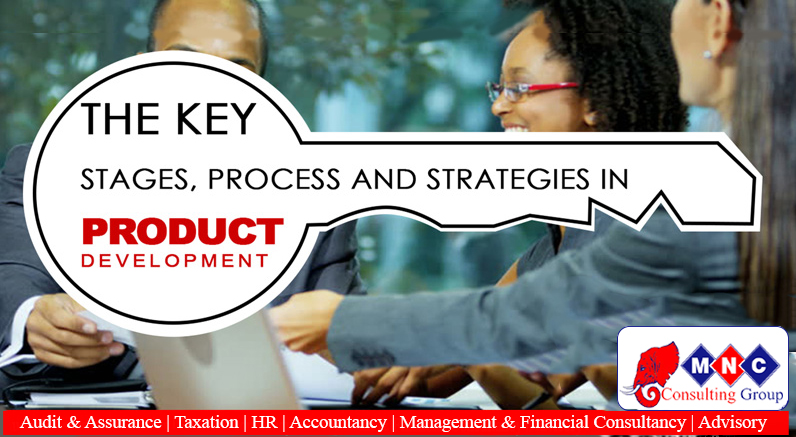
The key stages, processes and strategies in PRODUCT DEVELOPMENT
- October 25, 2021
- administrator
- Article
- No Comments
What is product development? This is the improvement of an existing product or the introduction of a new product in a market. Reasons for product development Company growth objectives; product development strategy is one of the keys enabling tools for the company to continually grow. For this reason, the company will be able to penetrate existing markets and new ones. Technological change; Companies may undertake this strategy not because it is a luxury but because it is a necessity for survival as technology emerges. Replace products at the maturity stage; when a company’s product reaches maturity stage, it can’t grow anymore hence has lower cash flow leading to the developing new ones to replace the products at the maturity stage. Response to both domestic and foreign competition; in this dynamic competitive business world, companies must develop strategies to respond to, outdo and overcome any form of competition that the business may pose. Changing customer’s requirements, needs, and tastes; Customers have a lot to choose from, are less brand loyal, and have changing needs, requirements, and taste for the product they need hence this strategy helps to overcome this. Criteria for successful new product development Have a uniquely superior product; the product should be highly differentiated, one of superior features, and of high quality. Well defined product concept; the company should carefully define and assess the target market, product requirement, and benefits. Technological and marketing synergy; Combination of both, technology and marketing strength brings a good breakthrough for the strategy. Quality of execution at all stages; should be quality-driven and high standards of high quality should be maintained at all stages. Avenues of New-Product Development A firm can obtain new products through: Acquisition; refers to the buying of a whole company, a patent, or a license to produce someone else’s product. New product development; involves the original products, product improvements, product modifications, and new brands developed from the firm’s own research and development. Reasons for new product failure Overestimation of market size Poor design Incorrect positioning Wrong timing Priced too high Ineffective promotion Management influence High development costs Competition New-Product Development Process 1. Idea generation New idea generation is the systematic search for new product ideas. To create a large number of ideas Sources of new-product ideas Internal sources this involves the company’s own formal research and development, management and staff, and intrapreneurial programs. External sources refer to sources outside the company such as customers, competitors, distributors, suppliers, and outside design firms. 2.Idea screening This refers to reviewing new-product ideas in order to drop poor ones as soon as possible. 3. Concept Development and Testing; This involves; Product ideas for a possible product that the company can see itself offering to the market. Product concept is a detailed version of the idea stated in meaningful consumer terms. Product image is the way consumers perceive an actual or potential product. Concept testing refers to testing new-product concepts with groups of target consumers. To find out how attractive each concept is to customers, and choose the best one. 4. Marketing strategy development This refers to the initial marketing strategy for introducing the product to the market. Marketing strategy statement Part 1: Description of the target market The planning product positioning; sales, market share, and profit goals Part 2: Price distribution and budget Part 3: Long-term sales, profit goals, and marketing mix strategy 5. Business analysis This involves a review of the sales, costs, and profit projections to find out whether they satisfy the company’s objectives. 6. Product Development This involves the creation and testing of one or more physical versions by the research and development (R&D) or engineering departments. Requires an increase in investment 7. Test marketing This is the stage at which the product and marketing program are introduced into more realistic marketing settings. Test marketing provides the marketer with experience in testing the product and entire marketing program before full introduction. A firms conduct test market when it has uncertainty about product or marketing program When firms may not test market: Simple line extension; Copy of competitor product; Low costs; Management confidence Approaches to test marketing a. Standard test markets Small representative markets where the firm conducts a full marketing campaign Uses store audits, consumer and distributor surveys, and other measures to gauge product performance The results of standard test markets are used to; Forecast national sales and profits Discover product problems Fine-tune the marketing program Challenges of standard test markets Cost Time Competitors can monitor the test as well Competitor interference Competitors gain access to the new product before introduction b. Controlled test markets Panels of stores that have agreed to carry new products for a fee Less expensive than standard test markets Faster than standard test markets Competitors gain access to the new product c. Simulated test markets Events where the firm will create a shopping environment and note how many consumers buy the new product and competing products Provides measure of trial and the effectiveness of promotion Researchers can interview consumers 8. Commercialization This is the introduction of the new product into the market. It involves; When to launch Where to launch Planned market rollout (the widespread public introduction of a new product ) Importance of new product development strategy to a firm Helps an organization to penetrate in its current market and enter new ones. It helps an organization to meet the changing customer’s needs as its continuous product development is guaranteed and facilitated. Assists an organization to achieve its growth objectives; through increased assortment, increased productive capacity of its facility. Performs as a strategy to curb competition. Acts as the basis for an organization to diversify across markets and increased product portfolio. New-Product Development Strategies a. Customer-centered new product development This focuses on finding new ways to solve customer problems and create more customer satisfying experiences Begins and ends with solving customer problems The most successful…
